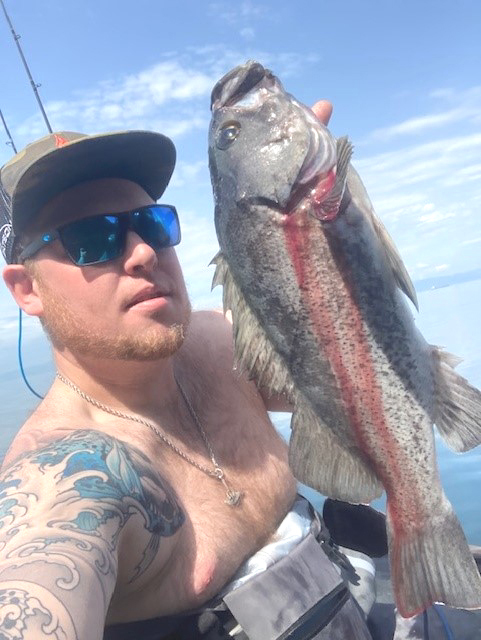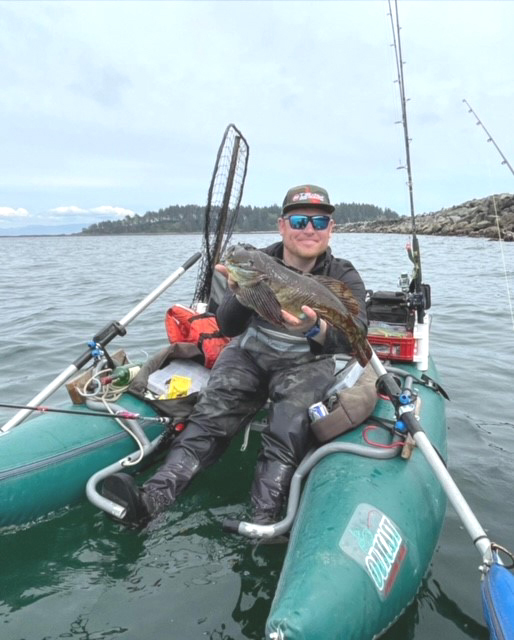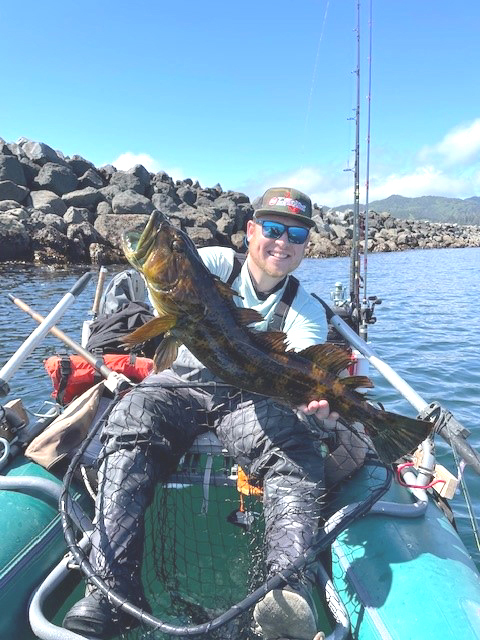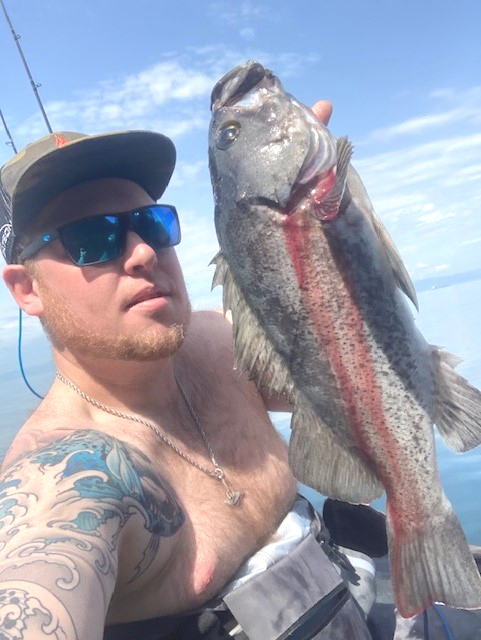By: Keller Batson


The sun begins to rise over the endless forests of the Olympic peninsula, mingling with the early morning expulsions of fog and dew. The calm sheen of the ocean, the sweep and wind of the mossy two-lane highway slips away beneath me. Every few feet showing the bumps and scars from its never-ending battle with mother nature. I cannot seem to drive fast enough; the siren call of the mighty pacific is pulling me faster and faster towards the little slip of beach I’ll be launching from. The rods are rigged, the tackle is organized, the boat prepped,and the cooler empty.
As I approach the launch the sounds of nature surround and replace the weeks stress with baited anticipation. Screaming eagles, squawking ravens, complaining seagulls, the barks of seals and sealions. Pulling my waders on and lacing my boots, I realize it’s been light for 30 minutes. I’m kicking myself for not rolling out of bed sooner. Its low tide and I’ve got my Outcast aluminum frame pontoon boat on my back. I Pick my way carefully through yards of tide pools with slippery piles of bull kelp squirming around my ankles. The undulating of the swell seems to match the beat of my heart as I load and strap the last bit of gear to my small one-man watercraft. The sky is overcast with the temperature hovering at 44 degrees. I am dressed appropriately, but the whisps of wind whipping around my head seems to find its way into every little crack and crevasse.

I drop into my seat, point the rear of my boat towards the kelp forest I’ll be targeting today then begin to pull. The oars move back and forth lulling me into a hypnotic state with their rhythmic motion as I look down into the alien world below me. Surprised creatures dart to-and-fro as I quietly slip overhead.One could come to this area with a large motorboat, but I’m after maneuverability and stealth.
After rowing for 5-10 minutes, I’ve reached water worthy of a cast. The first rod out of my quiver is the Rainshadow IMMC76MH, a 7’6” 8-17lb ¼-3/4oz spinning rod. My lure is a 5” white and silver soft plastic paddle tail, with a “knocker”creating a tantalizing rattle when retrieved. Having a way to go yet, rather than drifting slowly and searching for bites with “fan casts”, I choose to cast my bait behind me 20-30 yards and slow troll. The moment I touch the oars I feel the rod twitch and bend, I let go of the paddles and set the hook in one fluid motion. Just like that the first fish of the day is in my grasp. It’s a small Lingcod one to two pounds. With a quick pinch of my pliers the small fish reenters the water, I cast again and begin to row. I get about 7 bites and land 3 rockfish on my way to the kelp forest.
Upon reaching my destination I then decide to try and get my limit of 6 black rockfish first, before targeting lingcod. After looking for a school for 45 minutes or so I’ve caught 5 lings and 1 black rock. This is strange, in the past the reverse is usually the case. Lots of rockfish and less lingcod. But knowing theLingcod are spawning, there is likely a high volume of predators. Which is pushing the rockfish out of the area. My options having been weighed, and the decision being made. I reach back to my quiver and pull my lingcod stick. The SW966is an 8’, 12-20lb, ½-3oz, all-purpose RX7 graphite rod with a moderate fast action perfect for casting large 6-7” swimbaits. The lure of choice is a black bodied twin tailed scampi,with a red jig head weighing 1- 1/2oz. The fish are thick here today. In the first half hour I land 10 plus lings in the 2-10 lb. range. These fish come in so many different colors that without prior experience, one would think they had caught multiple species of fish. With brown, yellow, red, orange, iridescent neon blue, and combinations of all the above it can be hard to tell what’s on the other end of your line. The large variety of colors these fish exhibit is determined by diet, and the predominant hues of the environment in which the fish matured. Of course, my favorite is the neon blue variety. These fishes flesh appear as though they have swum straight out of the Fukushima reactor core. As though it would light up a dark room.
I’ve been targeting lings for 2 hours, boated 20 to 30. I can’t keep count. I cast the black split tail about 20 yards to the edge of some rocks and wait to feel my bait hit the bottom. Before I can turn my reel handle twice a nice ling freight trains my bait hard enough to drag me and my boat 5+ ft. My rod is doubled over, and I’m thumbing the line to keep this hot fish out of the rocks(a big no no in many fishing situations, but maybe breaking off is better than letting the fish get into the rocks and 100% breaking and losing my lure). Despite being mere feet from the boulders, due to today’s unique conditions I am in no danger of capsizing. Still, I don’t want to rub onto barnacles and mussels any more than I must. Thus, it is time to try and row clear of any obstacles to net this fish. I see the fish is hovering about 5ft below the surface while I keep tension on the line. Sliding the butt of the rod in between my legs and pinching the reel with my thighs, I begin to row away from the rocks. Now clear, I pick up my rod carefully pulling the fish towards me with my right arm, the net poised in my left. One quick shot and the 10 lb. fish is in the net. Grabbing it by the gill, I put it between my legs. Then once again use my thighs to squeeze the fish hard right on the gill plate. The fish immediately goes limp like a kitten held by the scruff. The fierce eyes of this predator look me up and down as I reach for my club. Two quick pops and it’s over. I cut one of its gills to drain blood from the meat and throw it into the cooler. Why into a cooler and not on a stringer? Most of the time when kayak fishing one would just dangle the fish in the water below the boat. But I know there are massive 1500+lb sea lions in the area. Just waiting for the opportunity at an easy meal. So, I am trying to reduce my chances of having an altercation with any massive pinnipeds.
My day on the water being about half over, I take stock of my catch so far. There are 4 rockfish and 1 lingcod in my cooler. It’s now time to use my favorite (and most effective) technique for targeting large lings, live baiting greenling AKA ling candy. The small tan up to 5 lb. fish is irresistible to the voracious lingcod. I put a small 2.5” bright red vertical jig onto my IMMC76MH and move right up to the edge of the bull kelp. Within 5 minutes I have landed a perfectly sized bait about 2lbs. The time has come use the last rod in my quiver. A red and black themed 30-60lb, 10-14oz, moderate action REVSJ70H-CW-CG slow jig rod. Originally designed to effortlessly fish vertical jigs for pelagic fish like tuna and yellowtail. The small diameter and unexpected power in this 7ft rod make it ideal for fishing from a small craft in tight quarters. I take out a 3-foot wire halibut leader and strategically place the hooks to allow my bait to swim as naturally as possible. Then tie a three-way snap swivel to my 50lb braided main line and snap a 6oz. lead ball on to the clip. Lowering all this to the bottom. I reel up a crank or two to keep from snagging the bottom and to get a good feel for the weight of my bait. Now that I have a feel for this set up, I drop and begin to wait. Tightening my drag I prepare the net and wait for the rod to bend double. The unique thing about this style of fishing is there are few exposed hooks. Most of the time, the only thing keeping the lingcod on the line is the predatory instinct hold onto its meal. It doesn’t take long before I feel the greenling swimming franticly back and forth on its tether.Indicating to me that a lingcod has zeroed in on the small baitfish. A few moments later my rod doubles over. The headshakes are violent as the lingcod rips at the bait below me. Its only 20-30ft to the bottom here so the fight will be short. Thus, the fish will not be tired once near the surface in range of the net, making for a highly unpredictable fight. My rod in my right hand and the net in my left. I pinch the bottom of the reticulum between my palm and its handle to reduce drag in the water. I slowly raise the rod and once close enough shoot my net below the fish. GOT HIM! As soon as the net touches the fish it feels trapped and dives. Nearly pulling the net out of my hand. I place my rod safely into the rod holder. I lift the fish out of the water to rest on top of my legs. This fish is not the one I was looking for. But being near 15lbs it is more than big enough for table fare. I would label it a medium inshore lingcod. The Washington State record is 61lbs, which would be about 5-6ft long. I decide to keep it.
With my ice box approaching capacity it’s time to start thinking about heading back. The tide is going out and this far north its movement can be dramatic. Today’s tidal swing is about 2 ft. prompting me to wait a bit longer. I could be humping my gear an extra 50-100 yards over kelp and slippery rocks if I rush out of here. With 4 rockfish and 2 lingcod, I am only two rockfish from my limit. Being little over a mile from the pullout, rather than pulling hard on the oars. I begin slow trolling back the way I came. Out goes a cast, then to the oars, pulling gently every 3 seconds to keeping my bait in the strike zone. I have gone 40ft and the rod tip twitches twice,then bends over double. From the feel of the fight, I can tell this is a most likely a rockfish. My instincts being correct, it’s a keeper about 3lbs. I repeat the process and before I know it, I am 2/3 of the way back to the launch, limited out.
Upon arriving on the beach, I look back on the day and reflect. The weather was unusually calm and uncharacteristically cooperative. An occurrence I cherish here on the temperamental northwestern pacific. Letting me spend my time fishing. Not fighting with mother nature for position. Proceeding to begin the end, I ease out of my seat and drag my boat up onto the beach. I snap a few pictures of my catch and wrap and secure the rods. I cut the lures off the reels and return them to the tackle box. Unstrap and deflate the pontoons before draining the cooler. All this taking me about a half hour, I see my gear is neatly stacked. Satisfaction radiates through me as I feel the lifelong itch had been temporarily scratched. I head home and my mind is relaxing now that I’ve got some white meat for the freezer. Lightly I grab the shifter and pull into drive. Already planning my next trip, the ocean slips away in my rear-view leaving shimmering memories fluttering to the forefront of my mind.

